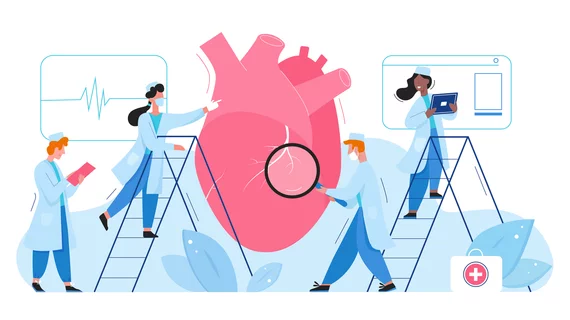Cardiologist demand is on the rise—can hospitals keep up?
The demand for cardiology services in the United States has been rising for years, and it’s not expected to slow down anytime soon.
There are many reasons for this shift, of course, including an aging patient population and the increased popularity of transcatheter aortic valve replacement (TAVR) and other advanced cardiac procedures, but how hospitals and health systems plan to keep up remains unclear.
Sg2, a Vizient company, explored this trend in a new report, “The Rising Tide of Cardiovascular Disease: A Looming Crisis for Cardiovascular Intervention Resources.” The report’s authors expect demand for inpatient cardiology procedures to increase by 8% and demand for outpatient cardiology procedures to increase by 25% in the next decade alone. This could have a substantial long-term impact on patient care, potentially putting patients at risk.
“We are seeing significant growth in heart valve diseases such as aortic stenosis due to underlying risk factors such as hypertension, high cholesterol, obesity and diabetes, as well as other cardiovascular diseases such as congestive heart failure,” Joshua Aaker, PhD, senior director at Sg2, said in a statement. “Hospitals struggling to provide timely access to interventions such as TAVR, will likely have sicker patients who need more intensive services and longer hospital stays.”
One trend Aaker et al. are watching closely is cardiac cath lab utilization over the next several years. They expect TAVR and percutaneous left atrial appendage closure volumes to skyrocket, for instance, while the volumes for percutaneous coronary intervention (PCI) and other common interventional procedures could either decrease or remain mostly flat. This could have a massive impact on the country’s cath labs, the group explained; TAVR requires more time and resources than some of these other procedures, for example, leaving cath labs with more to do and less time to do it in.
The power of optimized care: Short-term solutions to rising cardiologist demand
The team at Sg2 included several short-term solutions in its analysis. For instance, the group said, hospitals and health systems should start looking at potential ways to grow now, before things get too out of hand. By tracking the market and reviewing trends in the area, leaders can make better decisions and know what to expect. The report also recommends that leaders identify new ways to better optimize the space they already have. Can spaces be managed in a different way to make them more productive? Is there a better way physicians should be scheduled? These problems, and others, should be discussed at once.
The report also includes other potential short-term solutions to rising demand, including the implementation of artificial intelligence-powered patient management tools and shifting more low-risk patients to interventional treatments. Making same-day discharge (SDD) a reality for more and more patients is another suggestion, though providers will need to ensure they know how to properly assess patient eligibility for SDD.
Plan and expand: Long-term solutions to rising cardiologist demand
The report also dives into long-term recommendations for meeting cardiologist demand before it becomes too much for hospitals and health systems to handle. Implementing remote patient monitoring technology, for example, can help keep a close eye on more patients without a drop in care. Getting more advanced practitioners involved in cardiovascular care is another potential answer, though it is one that could require the development of new training programs.
Acquiring new spaces, including ambulatory surgery centers, is another way to plan ahead for this shift in patient needs. It will take some significant time and money, and executives will need to be convinced it is the right path forward, but growing in this manner is a productive way to prepare for the years ahead.
Read the full report, which goes into much more detail about possible treatment strategies, here.

